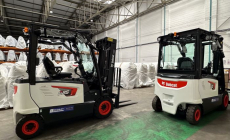-
QUECLINK NAMED LEADING TELEMATICS HARDWARE PROVIDER AFTER YEAR OF GROWTH AND INNOVATION - January 9, 2026
-
Women Leading the Way in the UK Material Handling Industry - December 12, 2025
-
LiftEx 2025 live from Liverpool - December 11, 2025
-
DATA ANALYSIS – THE FOUNDATION OF EVERY PEAK SEASON - December 5, 2025
-
Creative education specialists Creative Hut give 3PL full marks for onboarding excellence - December 5, 2025
-
Unlimited Industries raises $12M to build the AI construction company that will power America’s future - December 4, 2025
-
Scottish Leather Group gets full-support solution from Rushlift - December 4, 2025
-
Etaily lands strategic investment from Japan’s SMBC – bringing total funding to $24M for Social Commerce enablement platform - December 4, 2025
-
Winners lift their LEEA Awards and raise the industry - December 4, 2025
-
Prism eLogistics and Brand Angels Partnership Gives Brands the Full Package - December 3, 2025
Jess O’Dwyer, General Manager Europe of Pocketalk, emphasises the importance of embracing diversity as a strategy to attract and retain talent in the logistics sector.
As online shopping continues to surge, the logistics industry has grown rapidly, leading to a significant increase in the demand for workers. To address this demand, the industry has increasingly turned to foreign talent. In fact, according to research by Prologis UK, 12% of logistics, warehousing, and supply chain workers in the UK in 2023 were non-native English speakers.
This reliance on a diverse workforce underscores the logistics sector’s role in promoting workplace diversity and inclusion. However, it also brings forth challenges in communication. In logistics and operations, effective communication is critical. With the UK’s logistics sector being a cornerstone of the economy, ensuring that workplaces are accessible to non-native speakers is essential.
Addressing communication barriers is not just about meeting legal obligations; it’s about creating a more inclusive and efficient work environment. By investing in language inclusion, companies can enhance talent engagement and retention, drawing from a broader range of skills and perspectives. Additionally, reducing turnover rates through better communication leads to cost savings and less disruption. Fostering a supportive environment that minimises language barriers can boost job satisfaction, increase employee loyalty, and improve integrationHere are key strategies that UK operations and logistics companies can implement to build a more inclusive and effective workforce.
Recognising the Significance of Language Inclusion
Prioritising language inclusion goes beyond ticking compliance boxes – it’s crucial for operational excellence and employee well-being. Language barriers can result in misunderstandings, lower productivity, and even safety risks. When employees struggle to communicate, their confidence and job satisfaction are negatively impacted. In an industry where precision and efficiency are vital, miscommunication can have cascading effects throughout the supply chain, potentially leading to costly errors.
How Technology can Plug Communication Gaps
Technology plays a pivotal role in overcoming language barriers and fostering better communication. Devices like Pocketalk, a versatile language translation tool, can facilitate real-time communication between employees who speak different languages. By offering instant, accurate, and secure translation, such tools enable workers to understand instructions, report issues, and collaborate more effectively. Crucially, also helping ensure that safety protocols are understood and followed, thereby enhancing both safety and productivity in the workplace.
Investing in Language Training Initiatives
Although technology provides an immediate solution to overcome language barriers, long-term strategies should include investing in language training programmes. Offering English as a Second Language (ESL) classes can greatly benefit non-native speakers, improving their ability to communicate and perform their jobs effectively. Additionally, providing basic language courses for native English speakers to learn key phrases in their colleagues’ languages can foster mutual respect and understanding. These initiatives improve communication and demonstrate the company’s commitment to supporting its employees’ professional and personal growth.
Fostering a Multilingual Workplace
Creating a truly multilingual workplace involves embedding language inclusion into the company’s culture; a much greater commitment than just providing translation tools and language classes. This can be achieved by implementing bilingual signage and documentation, hiring multilingual support staff, and developing inclusive communication policies that encourage the use of multiple languages. By doing so, companies can ensure that all employees have access to vital information, regardless of their native language.
Real-World Success Stories
There are several real-world examples of how effective language inclusion can be. In the United States, CAVU, a leadership training company, assisted a business in the oil and gas sector by introducing language translation technology. This initiative led to improved communication, better leadership training, and enhanced safety. Another example is a manufacturing firm that partnered with local community organisations to offer ESL classes to their employees. This initiative not only improved workplace communication but also helped employees integrate better into their communities, leading to improved job satisfaction and quality of life.
Better Communication Gives a Competitive Edge
As globalisation continues to shape the workforce, the requirement to communicate across language barriers will become increasingly critical. UK operations and logistics companies can improve their operational efficiency as well as creating a more equitable and supportive workplace for all employees by prioritising language inclusion. This approach is key to retaining talent in the industry and ensuring long-term success in a diverse and dynamic global market.

































